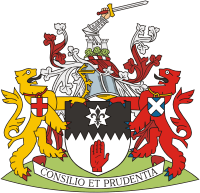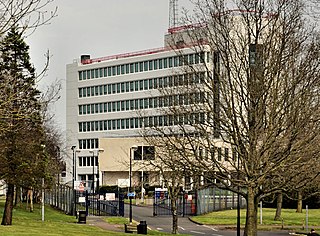
County Tyrone is one of the six counties of Northern Ireland, one of the nine counties of Ulster and one of the thirty-two traditional counties of Ireland. It is no longer used as an administrative division for local government but retains a strong identity in popular culture.

Omagh is the county town of County Tyrone, Northern Ireland. It is situated where the rivers Drumragh and Camowen meet to form the Strule. Northern Ireland's capital city, Belfast, is 68 miles (109.5 km) to the east of Omagh, and Derry is 34 miles (55 km) to the north.

The Omagh bombing was a car bombing on 15 August 1998 in the town of Omagh in County Tyrone, Northern Ireland. It was carried out by the Real Irish Republican Army, a Provisional Irish Republican Army (IRA) splinter group who opposed the IRA's ceasefire and the Good Friday Agreement, signed earlier in the year. The bombing killed 29 people and injured about 220 others, making it the deadliest single incident of the Troubles in Northern Ireland. Telephoned warnings which did not specify the actual location had been sent almost forty minutes beforehand but police inadvertently moved people toward the bomb.

Monaghan is the county town of County Monaghan, Ireland. It also provides the name of its civil parish and barony.

Dungannon is a town in County Tyrone, Northern Ireland. It is the second-largest town in the county and had a population of 14,340 at the 2011 Census. The Dungannon and South Tyrone Borough Council had its headquarters in the town, though since 2015 the area has been covered by Mid-Ulster District Council.

Fintona, is a village and townland in County Tyrone, Northern Ireland. Its population at the 2011 Census was 1,164.

Victoria Bridge is a small village in County Tyrone, Northern Ireland. It is mostly within the townland of Breen, which is in the civil parish of Ardstraw. It is also part of the historic barony of Strabane Lower, and Derry City and Strabane District Council. In the 2001 Census it had a population of 318 people. In the 2011 Census, it had a population of 420 people.
Charles Beattie was a Northern Irish farmer and auctioneer. Active in the Ulster Farmers' Union and in Unionist associations, he achieved senior office in the Orange Order and the Royal Black Institution and served on Omagh Rural District Council from 1952 until his death. He is principally known for an exceptionally brief career as a Member of the United Kingdom Parliament representing Mid Ulster: he did not win an election, but was declared elected when his opponent was disqualified. However, a few weeks after he took his seat, he was discovered to be holding an "office of profit under the Crown" which disqualified him.
Omagh St Enda's is a Gaelic Athletic Association club from Omagh, County Tyrone, Northern Ireland.
Drumragh Sarsfields is a Gaelic Athletic Association club based in the village of Clanabogan between Omagh and Dromore in County Tyrone, Northern Ireland. The club was founded in 1972 as a result of an amalgamation of Tattysallagh St. Eugenes and Tattyreagh St Patrick's GAC. Drumragh Sarsfields GAC is a quickly growing Club which has recently completed development of Clubrooms along with two pitches. Phase III of development is currently in progress.
St. John's Business and Enterprise College is a Roman Catholic secondary school for boys and girls based in the village of Dromore, County Tyrone, Northern Ireland. It is in the Western Education and Library Board area.

William Hague Jr. (1836–1899) was a well-known Irish Roman Catholic ecclesiastical architect active throughout mid- to late-nineteenth-century Ireland, particularly in Ulster. He is known as a protégé of A.W.N. Pugin. His office was located at 50 Dawson Street, Dublin.
Thomas Francis McNamara, RIAI, RIBA, (1867–1947) was an Irish Roman Catholic ecclesiastical architect active throughout the late-nineteenth- to the mid-twentieth-century Ireland who designed many hospitals and Roman Catholic churches. He was a pupil and later managing assistant of William Hague Jr., partner of the architectural firms Hague and McNamara and, later, T. F. McNamara. He was father of architects N.P. McNamara and Charles G. McNamara, who were partners in his firm from the 1920s, the latter absorbed his practice into his own.
The Teebane bombing took place on 17 January 1992 at a rural crossroads between Omagh and Cookstown in County Tyrone, Northern Ireland. A roadside bomb destroyed a van carrying 14 construction workers who had been repairing a British Army base in Omagh. Eight of the men were killed and the rest were wounded. Most were civilians, while one of those killed and two of the wounded were British soldiers. The Provisional Irish Republican Army (IRA) claimed responsibility, saying the workers were targeted because they were collaborating with the "forces of occupation".

Tyrone County Council was the authority responsible for local government in County Tyrone, Northern Ireland.

The Tyrone and Fermanagh Hospital is a mental health facility in Omagh, County Tyrone, Northern Ireland. It is managed by the Western Health and Social Care Trust.

The Bishop Street Courthouse is a judicial facility in Bishop Street, Derry, County Londonderry, Northern Ireland. It is a Grade A listed building.

Omagh Courthouse is a judicial facility in High Street, Omagh, County Tyrone, Northern Ireland. It is a Grade B+ listed building.

County Hall is a municipal facility in Coleraine, County Londonderry, Northern Ireland. It served as the headquarters of Londonderry County Council from 1960 to 1973.

County Buildings is a municipal facility in East Bridge Street, Enniskillen, County Fermanagh, Northern Ireland. It served as the headquarters of Fermanagh County Council from 1960 to 1973.















